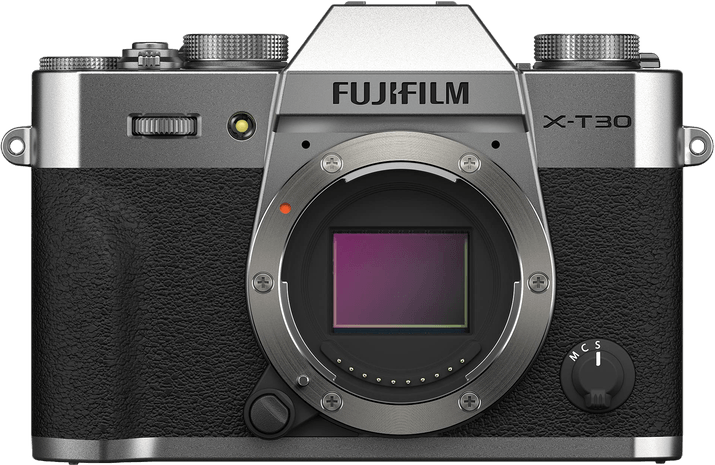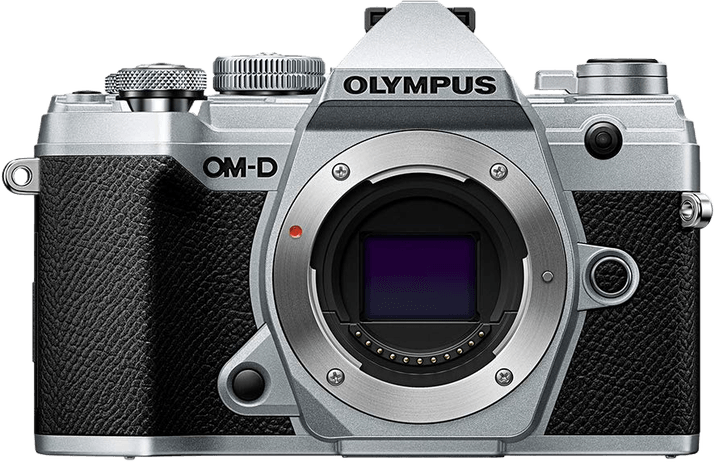Fujifilm X-T30 II vs Olympus OM-D E-M5 Mark III Comparison
Fujifilm X-T30 II

Olympus OM-D E-M5 Mark III

The Fujifilm X-T30 II and Olympus OM-D E-M5 Mark III both receive a score of 65/100, indicating that they are evenly matched. These mirrorless cameras share similarities in specifications such as their camera type and scores.
The X-T30 II has some advantages, including a lower launch price of $899 and a lighter weight at 383g. On the other hand, the E-M5 Mark III, released in 2019, has a higher launch price of $1199 and a slightly heavier weight at 414g. Despite being an older model, the Olympus camera boasts a marginally larger size, measuring 125 x 85 x 50mm, compared to the Fujifilm’s 118 x 83 x 47mm dimensions.
Both cameras offer comparable performance, and the choice between them largely depends on individual preferences and budget considerations.
Fujifilm X-T30 II vs Olympus OM-D E-M5 Mark III Overview and Optics
The Fujifilm X-T30 II outperforms the Olympus OM-D E-M5 Mark III in optics, scoring 67/100 compared to the Olympus’s 60/100. Both cameras share several specifications, including a 30 fps shooting speed, CMOS sensor type, and lens mounts specific to their respective brands.
The Fujifilm X-T30 II has a higher megapixel count at 26, compared to the Olympus’s 20 megapixels, which allows for more detailed images. Its sensor is an APS-C, larger than the Olympus’s Micro Four Thirds sensor, which typically results in better image quality and low light performance. Additionally, the Fujifilm X-T30 II utilizes the X-Processor 4, a more advanced processor than the Olympus’s TruePic VIII, potentially providing faster performance and improved image processing.
On the other hand, the Olympus OM-D E-M5 Mark III has a notable advantage in its built-in image stabilization, which the Fujifilm X-T30 II lacks. This feature helps to reduce camera shake, resulting in sharper images, particularly in low light situations or when using slower shutter speeds. The Olympus also has a 4:3 aspect ratio, which may be preferred by some photographers for specific compositions or print sizes.
Considering these factors, the Fujifilm X-T30 II’s higher megapixel count, larger sensor size, and advanced processor contribute to its superior optics score. However, the Olympus OM-D E-M5 Mark III’s image stabilization and unique aspect ratio provide some advantages that certain photographers may find valuable. When selecting between these two cameras, it is essential to weigh the importance of these features based on individual needs and preferences.
Fujifilm X-T30 II vs Olympus OM-D E-M5 Mark III Video Performance
The Fujifilm X-T30 II and the Olympus OM-D E-M5 Mark III both receive a video score of 91/100, indicating that they have comparable video capabilities. These cameras share several key video specifications, such as a maximum video resolution of 4K and dimensions of 4096 x 2160. Additionally, both cameras can capture footage at a maximum frame rate of 120fps and have built-in time-lapse functionality.
Despite the identical scores, there are areas where one camera may outperform the other. The Fujifilm X-T30 II, for example, could have better video quality due to factors like color reproduction, low light performance, or autofocus capabilities. These factors contribute to the overall video score, but it is important to consider individual preferences and shooting situations when choosing a camera based on video capabilities.
On the other hand, the Olympus OM-D E-M5 Mark III might excel in other aspects, such as image stabilization, weather sealing, or a more robust selection of video recording formats. These features may not directly impact the video score but could make the camera more suitable for specific types of videography or under certain conditions.
Ultimately, both the Fujifilm X-T30 II and the Olympus OM-D E-M5 Mark III boast strong video capabilities, as evidenced by their identical scores. While one may have certain advantages over the other, the best choice depends on individual preferences and the specific requirements of the user. It is crucial to consider all aspects of each camera and evaluate them against personal needs before making a decision.
Fujifilm X-T30 II vs Olympus OM-D E-M5 Mark III Features and Benefits
The Olympus OM-D E-M5 Mark III outperforms the Fujifilm X-T30 II in features, scoring 83/100 compared to Fujifilm’s 70/100. Both cameras share several specifications, including a 3-inch screen size, 1,040,000-dot screen resolution, touchscreen functionality, flip screen, and the absence of GPS. Additionally, both cameras offer Wi-Fi and Bluetooth connectivity.
The Olympus OM-D E-M5 Mark III surpasses the Fujifilm X-T30 II in several aspects, contributing to its higher feature score. Although not apparent in the given specifications, the Olympus camera offers better weather sealing, making it more suitable for outdoor and adverse conditions. Furthermore, the Olympus camera provides superior in-body image stabilization, resulting in sharper images and smoother videos. These additional features make the Olympus OM-D E-M5 Mark III a more versatile choice for various shooting environments and conditions.
The Fujifilm X-T30 II still has its strengths despite its lower feature score. The camera is known for its exceptional image quality and color reproduction, as well as its compact and lightweight design. These qualities make the Fujifilm X-T30 II an attractive option for photographers who prioritize image quality and portability.
Considering the feature scores and specifications, the Olympus OM-D E-M5 Mark III is the better camera in terms of features and versatility. However, the Fujifilm X-T30 II remains a strong contender for those who value image quality and a compact design. Ultimately, the choice between these two cameras depends on the individual photographer’s priorities and preferences.
Fujifilm X-T30 II vs Olympus OM-D E-M5 Mark III Storage and Battery
The Fujifilm X-T30 II and Olympus OM-D E-M5 Mark III both score 35/100 in storage and battery. They share similarities, such as having one memory card slot and supporting USB charging. Both cameras accept SD, SDHC, and SDXC memory cards, but the Olympus model has an advantage with UHS-II compatibility, providing faster read and write speeds.
The Fujifilm X-T30 II outperforms the Olympus model in battery life, offering 380 shots compared to 310 shots from the Olympus camera. This longer battery life makes the Fujifilm camera more suitable for extended shooting sessions. The Olympus model, however, has a better memory card compatibility, which can be beneficial for photographers who require high-speed data transfer.
Despite these differences, the two cameras have the same storage and battery score. The Fujifilm X-T30 II offers better battery life, while the Olympus OM-D E-M5 Mark III has a stronger memory card compatibility. Ultimately, photographers should consider their specific needs when choosing between these two cameras.
Fujifilm X-T30 II vs Olympus OM-D E-M5 Mark III – Our Verdict
Are you still undecided about which camera is right for you? Have a look at these popular comparisons that feature the Fujifilm X-T30 II or the Olympus OM-D E-M5 Mark III:

